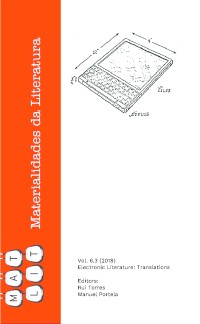Please use this identifier to cite or link to this item:
https://hdl.handle.net/10316.2/44389| DC Field | Value | Language |
|---|---|---|
| dc.contributor.author | Gobira, Pablo | - |
| dc.date.accessioned | 2018-10-24T10:23:19Z | |
| dc.date.accessioned | 2020-10-04T00:49:43Z | - |
| dc.date.available | 2018-10-24T10:23:19Z | |
| dc.date.available | 2020-10-04T00:49:43Z | - |
| dc.date.issued | 2018 | - |
| dc.identifier.issn | 2182-8830 | - |
| dc.identifier.uri | https://hdl.handle.net/10316.2/44389 | - |
| dc.description.abstract | Este artigo apresenta uma interface para poesia que foi desenvolvida no Laboratório de Poéticas Fronteiriças (http://labfront.tk). LabFront é um grupo de pesquisa registrado no CNPq (Brasil) e certificado pela Universidade do Estado de Minas Gerais. Como uma de nossas atividades no LabFront, o desenvolvimento de um sistema poético chamado “Aleph” é uma evocação do conto ho-mônimo de Jorge Luiz Borges que apresenta a primeira letra do alfabeto hebreu como protagonista. Aleph poderia ser o ponto onde tudo estaria contido. Baseado nessa ideia, uma das equipes do LabFront começou a criar um código para desconstruir poemas e gerar expressões sonoras diferentes da leitura linear. Neste trabalho iremos, em um primeiro momento, apresentar a relação desse sistema com as vanguardas do século XX. Posteriormente, explicaremos como o sistema funciona no momento atual de seu desenvolvimento. | por |
| dc.description.abstract | This paper presents an interface for poetry that has been developed at the Laboratory of Front Poetics (http://labfront.tk). LabFront is a research group registered at CNPq (Brazil) and certified by the State University of Minas Gerais. As one of our activities at LabFront, the development of the poetic system called “Aleph” is a reminder of the homonymous tale by Jorge Luiz Borges, which presents the first letter of the Hebrew alphabet as its protagonist. Aleph would be the point where everything would be contained. Based on this idea, one of the LabFront teams started to make a code for deconstructing poems and to generate a sound expression different from linear reading. In this work I will start by presenting the relationship of this system with the avant-gardes of the twentieth century, and later I will explain how it works in its current implementation. | eng |
| dc.language.iso | eng | - |
| dc.publisher | Centro de Literatura Portuguesa | - |
| dc.publisher | Imprensa da Universidade de Coimbra | - |
| dc.rights | open access | - |
| dc.subject | digital arts | eng |
| dc.subject | Aleph system | eng |
| dc.subject | immersive virtual reality | eng |
| dc.subject | poetry reading | eng |
| dc.subject | artistic installation | eng |
| dc.subject | artes digitais | por |
| dc.subject | sistema Aleph | por |
| dc.subject | realidade virtual imersiva | por |
| dc.subject | leitura de poesia | por |
| dc.subject | instalação artística | por |
| dc.title | Avant-gardes and the Aleph System: an artistic interface for digital arts | por |
| dc.type | article | - |
| uc.publication.collection | Matlit v. 6, nº 3 | - |
| uc.publication.firstPage | 165 | - |
| uc.publication.issue | 3 | - |
| uc.publication.lastPage | 169 | - |
| uc.publication.location | Coimbra | - |
| uc.publication.journalTitle | MATLIT: Materialidades da Literatura | - |
| uc.publication.volume | 6 | por |
| dc.identifier.doi | 10.14195/2182-8830_6-3_14 | - |
| uc.publication.orderno | 14 | - |
| uc.publication.area | Artes e Humanidades | - |
| uc.publication.manifest | https://dl.uc.pt/json/iiif/10316.2/44389/263736/manifest?manifest=/json/iiif/10316.2/44389/263736/manifest | - |
| uc.publication.thumbnail | https://dl.uc.pt/retrieve/12074951 | - |
| item.grantfulltext | open | - |
| item.fulltext | With Fulltext | - |
| Appears in Collections: | Matlit | |
Files in This Item:
| File | Description | Size | Format | |
|---|---|---|---|---|
| avant-gardes_and_the_aleph_system.pdf | 619.08 kB | Adobe PDF |  |
Items in DSpace are protected by copyright, with all rights reserved, unless otherwise indicated.
